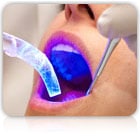Cosmetic dentistry is the process of improving the appearance of a person’s teeth, gums and smile.
Cosmetic dentistry, over the years, has evolved into a dynamic and multifaceted field dedicated to not only enhancing the aesthetics of your teeth and gums but also prioritizing your overall oral health.
The American Dental Association (ADA), while not officially recognizing cosmetic dentistry as a distinct specialty, acknowledges the invaluable contributions of cosmetic dentists, who have undergone extensive education, specialized training, and gained substantial experience in transforming the visual appeal of a person’s oral appearance.
Cosmetic dentistry procedures differ from general dentistry or restorative dentistry procedures in that they are elected as opposed to required.
Cosmetic dentistry has the added dimension of art as well as combining the oral health benefits of general and restorative dentistry to give patients the smile they have dreamed of.
The latest advancements in dental technology have allowed cosmetic dentists to utilize materials that are both durable and esthetically pleasing.
The amount of additional training cosmetic dentists undergo allows them to blend both art and science into smiles that are healthy and beautiful.
Materials such as porcelain or composite materials are closely matched to resemble the look and feel of your original teeth, giving a natural appearance of your teeth and smile that enhance one’s oral appearance.
Cosmetic dentistry has also taken leaps in utilizing less invasive techniques that conserve as much natural tooth as possible.
These practices combined with advancements in natural-looking, tooth-colored dental materials make today’s cosmetic dental treatments more durable and predictable than in years past.
In addition to these advancements, many cosmetic dentists are available to perform many procedures in-office that used to require referrals to other specialists.
The need for patients to see multiple dental care providers and experience multiple trips has been replaced by more convenient and advanced procedures and has reduced recovery time.
Cosmetic Dental Procedures
Dental Implants
A dental implant is a form of cosmetic dentistry used to replace missing teeth for a look and feel that is natural. Dental implants are long-term replacements that your cosmetic dentist or oral and maxillofacial surgeon surgically places in the jawbone. With the exception of children, dental implants can be a healthy solution for people of all ages and are a good alternative to dentures or partials.
Dental Bonding
Tooth bonding is the application of a tooth-colored resin material using adhesives and ahigh-intensity curing light. Bonding is typically used for cosmetic purposes to improve the appearance of a discolored or chipped tooth, close spaces between teeth, to make teeth look longer or to change the shape or color of teeth. It is also used as an alternative to amalgam fillings, or to protect a portion of the tooth’s root that has been exposed when gums recede.
Dentures
Dentures are used to replace missing teeth that can be taken out and put back into your mouth. There are generally two types of dentures available: complete dentures and partial dentures. Dentures are used so that patients who suffer from tooth loss don’t have to suffer the negative effects of not having teeth. They are free to eat and drink most foods and don’t suffer from the sagging facial appearance that occurs with missing teeth.
Invisalign
Invisalign is the most popular alternative to orthodontic appliances such as braces because they employ a clear tooth aligner that is invisible to the eye. Users are attracted to this product because it allows them to straighten their teeth while maintaining a professional appearance. The aligners fit comfortably over the teeth and gradually straighten them the same way braces do.
Teeth Whitening
Tooth whitening is the most common cosmetic dentistry procedure because it can significantly improve the appearance of your teeth at much less cost and inconvenience than other techniques. There are various types of teeth whitening treatments available ranging from in-office bleaching to take-home kits that take a few weeks. Each method has its pros and cons and you can learn more about them here.
Braces
Braces are an orthodontic corrective appliance used most commonly to properly align teeth. Often times a cosmetic dentist may recommend braces before other cosmetic procedures because a misaligned mouth can lead to various dental health problems. A bad bite can make maintaining teeth more difficult and can lead to oral health problems that would have been much cheaper and easier to prevent than to fix.
Veneers
Dental veneers are custom-made ultra-thin shells of tooth-colored materials designed to cover the front surface of teeth to improve your appearance. They can remedy the look of teeth that are chipped, discolored, misaligned, uneven, worn down, or abnormally spaced. The result of a dental veneer treatment is teeth that are bright and beautifully aligned and look and feel completely natural.
Cosmetic dentistry offers many opportunities to restore and enhance teeth that may suffer the effects of aging, trauma, poor genetics, or general wear-and-tear.
If you wish to improve your smile and appearance consult with an experienced cosmetic dentist that is affiliated with the ACE network to ensure the best in patient care and dedication to excellence.
Cosmetic Dentistry Materials
The choice of materials plays a pivotal role in the success of any cosmetic dentistry treatment. Modern advancements have supplanted traditional materials like gold and amalgam with options that closely resemble the look and feel of natural teeth.
Materials such as porcelain and resin composite not only offer a natural appearance but also match the durability of real teeth. Cosmetic dentists bond these materials to the underlying tooth structure, meticulously crafting restorations that harmonize seamlessly with your natural teeth.
The consideration of materials may affect the outcome of your cosmetic dentistry treatment, as some materials may vary in cost and appearance.
Dental ceramics with a high glass content, for example, closely mimic the optical properties of enamel and dentin. Your cosmetic dentist will collaborate with you to select materials that align with your unique characteristics, such as opalescence, color, and opacity, ensuring a final result that is both beautiful and enduring.
Cosmetic dentistry has evolved significantly since its inception, offering a wealth of opportunities to restore and enhance teeth affected by aging, trauma, genetics, or general wear-and-tear.
If you aspire to elevate your smile and overall appearance, consult with an experienced cosmetic dentist affiliated with the ACE network, ensuring the highest standards of patient care and a commitment to excellence.
Learn more:







